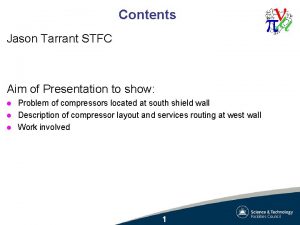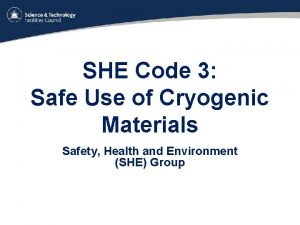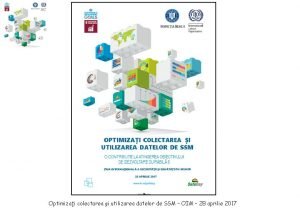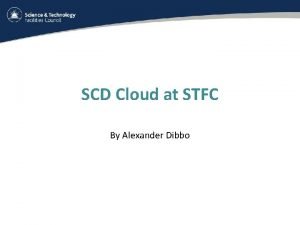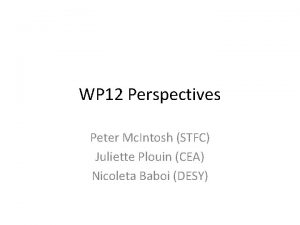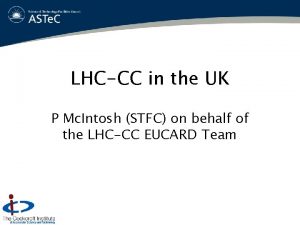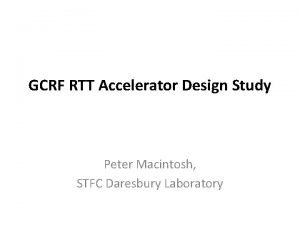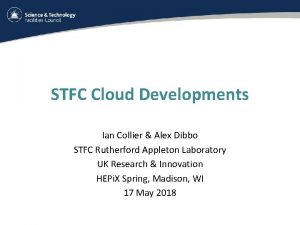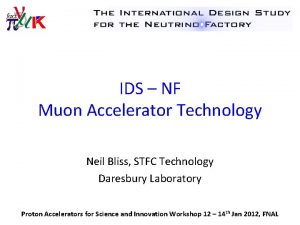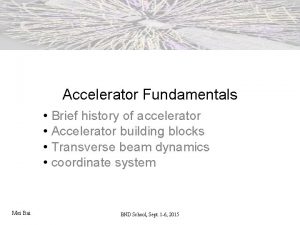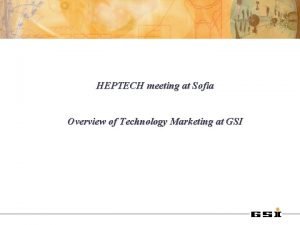Stateoftheart Accelerator Technology Peter Mc Intosh STFC HEPTech












- Slides: 12

State-of-the-art Accelerator Technology Peter Mc. Intosh, STFC HEPTech Environmental Applications of Accelerators 9 th July 2013

Accelerators in context • Estimated 24, 000 accelerators globally – Only 200 used for research – less than 1% • Used in: – Healthcare - radio-/hadron-therapy, radioisotope production, medical sterilisation – Security - threat detection, cargo screening – Manufacturing - polymer cross-linking (wires, cables, tyres etc. ), ink curing, food irradiation – Environment - waste water treatment, flue gas treatment

Accelerators in context • Pervasive technology (more than commonly realised), ~€ 400 bn/yr of end products will have seen an accelerator. • Advances in technology therefore have huge potential for impact across range of sectors. – We want to unlock the potential of technological advances for the benefit of UK industry

Drivers for increased uptake • To promote uptake in the environmental sector, we need to optimise technology solutions to commercial needs • Smaller – often replacing pre-installed equipment, smaller footprint = reduced building and infrastructure costs • Cheaper – reduced initial capital investment • More efficient – reduced on-going resource costs • More reliable – reduced Mean Time Between Failure, easier maintenance • (Improved) performance – optimised to application • Easier to operate – fits into standard protocols and operations • Repeatable – confident that you get the same outcome every time

Key Technology Developments Radio Frequency Systems Collaborative Design Visualisation Vacuum Systems Innovative accelerator technology and concepts Modelling & Simulation Photocathodes Magnet Systems

Compact Linacs • Compact linac system demonstrated, with potential to reduce the footprint and cost of systems across a broad range of applications. Higher energy system now under development. • Unique technology may open up the possibility of using cheaper RF power components, without degrading performance.

RF Power Developments • Semiconductor amplifiers close-coupled to the cavity. – Possible substitute for expensive, customised klystrons (a significant proportion of the total accelerator system cost) – Reduces transmission losses, more electrically efficient (>70%) – Possible significant footprint reduction – Potential for user servicing and upgrades • Similarly, higher peak and average power magnetrons are opening up new opportunities to replace klystrons and deliver higher average beam currents.

Material Developments • Superconducting multilayers to supplement or replace expensive bulk material (e. g. niobium) • High temperature superconductors may bring enhancements in the longer term • Non-evaporable getter (NEG) coatings to enhance vacuum systems and reduce pumping system size and complexity

Fast Prototyping / Value Engineering Modelling Rapid Prototyping Simulation Engineering Design

Novel Accelerators FFAG Laser Plasma Wakefield Superconducting Cyclotron Oniac

Process Optimisation • Significant opportunities to reduce the dose (and therefore infrastructure investment) by optimising how the accelerated beams interact with other ‘conventional’ techniques in the clean-up process (e. g. filtration, reduction, oxidation, aggregation, disintegration etc. ) • Therefore it is critical to promote dialogue between end users, technology suppliers and the academic base

Summary • Accelerators are not just big R&D tools - commercial use of accelerators is widespread in many sectors • Technology developments are underway which will reduce the size, cost and complexity of accelerators • The expertise exists in the UK to translate these developments into commercial systems • Open dialogue is the key to fully identifying user needs and finding optimal solutions







